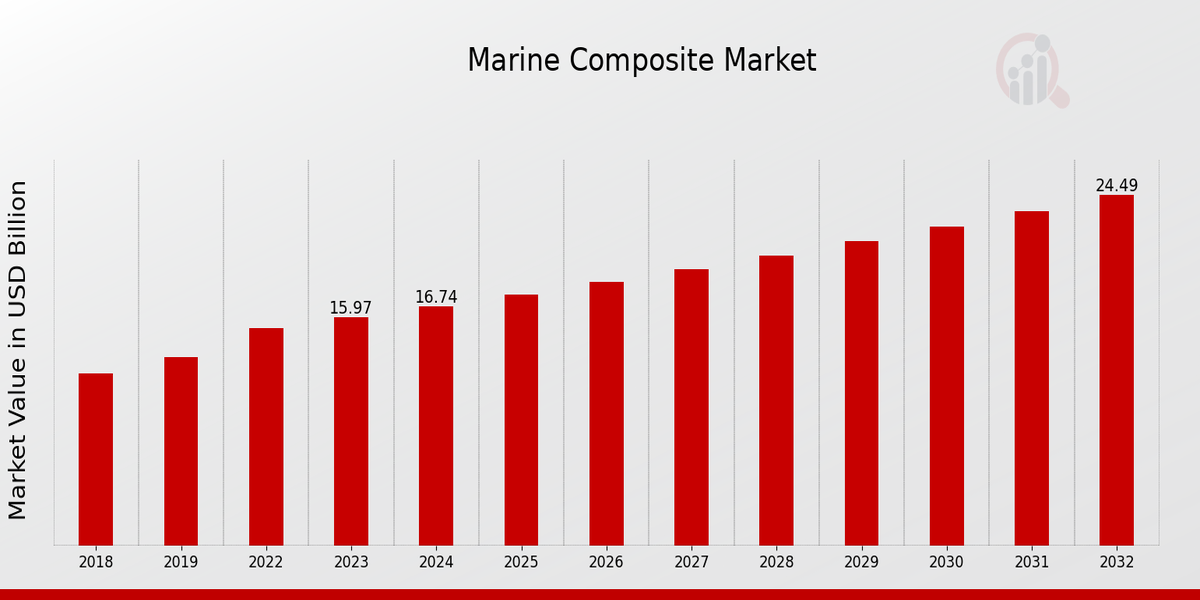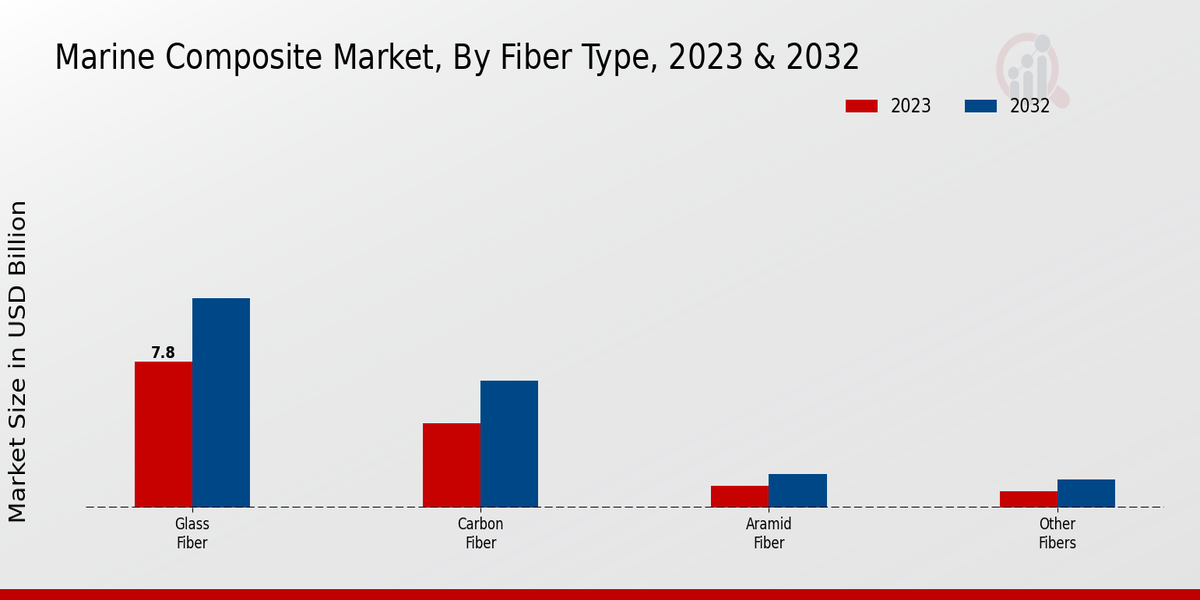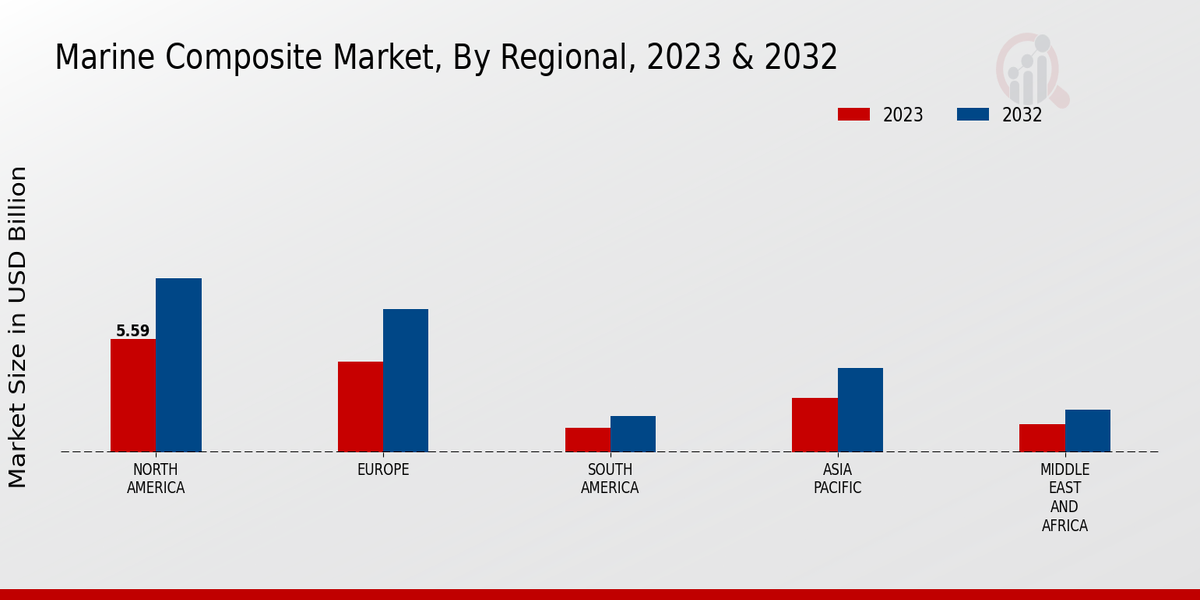Global Marine Composite Market Overview
Marine Composite Market Size was estimated at 17.55 (USD Billion) in 2024. The Marine Composite Industry is expected to grow from 18.41(USD Billion) in 2025 to 28.25 (USD Billion) by 2034. The Marine Composite Market CAGR (growth rate) is expected to be around 4.90% during the forecast period (2025 - 2034).
Key Marine Composite Market Trends Highlighted
The size of the marine composites market is expected to grow considerably due to rising demand for lightweight and strong materials in ship and offshore industries. These include advanced composite materials like carbon fiber and fiberglass, which provide better resistance to corrosion, a greater strength-to-weight ratio and a longer life span than regular materials.
Trends such as the use of green composites in response to ecological concerns, as well as the improvements in the technologies for producing them to increase production efficiency and reduce costs, are also anticipated. In addition, recreational boating and other water-related activities are also increasing the usage of composite materials in boat hulls, decks, and other parts, increasing the demand for boat composites. There are also growth potentials in the marine composites market in the form of submarines, sub-sea cables, buoyancy modules and many more.

Source Primary Research, Secondary Research, MRFR Database and Analyst Review
Marine Composite Market Drivers
Increasing Adoption of Marine Composites in Shipbuilding and Offshore Structures
The marine composite market is majorly driven by the increasing application of marine composites in shipbuilding and offshore applications. Marine composites have several advantages over conventional materials such as steel and aluminum. They provide high strength to weight ratio, corrosion resistance, and maximum design flexibility. Thus, they are used in a wide range of marine applications such as boat hulls and decks, superstructures of boats and ships, and offshore platforms and wind turbine blades.
Therefore, the demand for marine composites in the shipbuilding and offshore market is likely to grow. The marine composite market is also likely to be driven by the increasing demand for fuel-efficient and lightweight ships and structures. Marine composites can be used to manufacture ships and structures that have reduced weight, which results in significant fuel savings. They also help to improve the performance of ships and structures in harsh marine environments.
For instance, hulls manufactured from marine composites are more resistant to impact and corrosion. Thus, the shipbuilding and offshore market is likely to be the key application segment of the marine composite market. Owing to these factors, the marine composite market is expected to reach a value of USD 24.5 billion by 2032, registering a CAGR of 4.87% during the forecast period from 2024 to 2032.
Rising Demand for Marine Composites in the Renewable Energy Sector
Another key driver of the marine composite market is the increasing demand for marine composites in the renewable energy sector. Marine composites are used in the construction of offshore wind turbines and other renewable energy structures. The main reason for this is that marine composites are lightweight and strong, and they are able to withstand the harsh marine environment. Moreover, marine composites can be used to form complex shapes and structures, which is perfect for the purpose of constructing offshore wind turbines and other renewable energy structures.
Since the demand for renewable energy is constantly increasing, the demand for marine composites in the renewable energy sector is also expected to increase. Overall, this trend will be one of the key market drivers of the marine composite market in the future.
Growing Awareness of the Environmental Benefits of Marine Composites
Finally, the growing awareness of the environmental benefits of marine composites is also driving the growth of the marine composite market. Marine composites are more environmentally friendly than traditional materials such as steel and aluminum. This is because marine composites can be recycled, and they do not produce harmful emissions during their production and use. In addition, marine composites can help to reduce the weight of vessels and structures, which can lead to reduced fuel consumption and emissions.
As the awareness of the environmental benefits of marine composites continues to grow, the demand for marine composites in a wide range of applications is expected to increase. This is expected to be a major driver of the marine composite market in the coming years.
Marine Composite Market Segment Insights
Marine Composite Market Fiber Type Insights
One of the key segments of the Marine Composite Market, according to the Fiber Type, is serviced by Glass Fiber, Carbon Fiber, Aramid Fiber, and Other Fibers. Glass Fiber is the leading segment with a revenue of USD 7.8 billion in 2023 and is expected to grow at a CAGR of 4.2% and reach USD 11.2 billion by 2032. Its overwhelming size is explained by the cost-effective production of this material, its high strength-to-weight ratio, and ease of application and handling. Carbon Fiber is another large segment, valued at USD 4.5 billion in 2023 and reaching USD 6.8 billion by 2032 with a CAGR of 5.1%.
This type of fiber has high stiffness and low weight, and it is also immune to chemicals and corrosion, which makes it suitable for the most advanced applications, such as racing boats or militarily vessels. Aramid Fiber, which is also renowned for its high strength and impact resistance, is set to be worth USD 1.2 billion in 2032, increasing at a CAGR of 4.5%. Finally, Other Fibers, which include Basalt Fiber and Natural Fibers, are promoted by the concerns for the environment and a general tendency towards cost savings and, hence, offer the fastest growth rates in the Marine Composite market.

Source Primary Research, Secondary Research, MRFR Database and Analyst Review
Marine Composite Market Product Type Insights
The Product Type segment of the Marine Composite Market is characterized by a diverse range of products used in the construction and maintenance of marine vessels. Hull Structures, the largest segment, accounted for over 40% of the market revenue in 2023. The demand for lightweight and durable hull structures is driven by the need to improve vessel performance and reduce fuel consumption. Decking, the second-largest segment, is expected to witness significant growth due to increasing demand for composite decking materials that offer better durability and aesthetics compared to traditional materials.
Superstructures, Piping and Fittings, and Other Products are other key product types in the market, each serving specific applications in the marine industry. The Marine Composite Market is expected to reach a value of USD 18.7 billion by 2024, driven by factors such as increasing demand for lightweight and corrosion-resistant materials, rising adoption of composite materials in offshore wind energy applications, and growing awareness of environmental sustainability.
Marine Composite Market Application Insights
The Application segment plays a pivotal role in shaping the growth of the Marine Composite Market. Yachts and Leisure Boats accounted for the lion's share of the market in 2023, owing to the increasing demand for recreational boating activities. In 2023, this segment generated a revenue of USD 5.69 billion and is projected to reach USD 8.23 billion by 2032, exhibiting a CAGR of 4.2%. Commercial Vessels, which include cargo ships, tankers, and passenger ferries, are another significant application segment, with a market size of USD 4.12 billion in 2023.
This segment is expected to witness steady growth over the coming years, driven by the expansion of trade and maritime transportation. Military Vessels, including warships, submarines, and patrol boats, constitute a specialized segment of the market, with a market value of USD 2.78 billion in 2023. This segment is influenced by geopolitical factors and government defense spending. Offshore Structures, such as oil rigs, wind turbines, and floating platforms, represent a growing segment of the market, with a market size of USD 2.15 billion in 2023.
The increasing demand for offshore exploration and renewable energy sources is driving growth in this segment. Other Applications, which include various smaller applications such as marine infrastructure, sporting goods, and medical equipment, accounted for a market size of USD 1.23 billion in 2023. This segment is expected to witness moderate growth in the coming years.
Marine Composite Market Manufacturing Process Insights
The Marine Composite Market segmentation by Manufacturing Process includes Hand Lay-Up, Vacuum Infusion, Resin Transfer Molding, Compression Molding, and Other Processes. The Hand Lay-Up process is expected to hold the largest market share in 2023, due to its cost-effectiveness and simplicity. Vacuum Infusion is projected to witness significant growth during the forecast period, owing to its ability to produce high-quality composites with reduced labor costs. Resin Transfer Molding is another widely used process, particularly for complex shapes and large-volume production.
Compression Molding offers high production rates but is limited to specific composite materials. Other Processes, such as filament winding and pultrusion, cater to niche applications requiring specific properties.
Marine Composite Market Regional Insights
The Marine Composite Market regional segmentation provides insights into the market's geographic performance and growth potential. In 2023, North America held a dominant position in the market, accounting for over 35% of the total revenue. This region is projected to maintain its lead throughout the forecast period, driven by factors such as the presence of leading marine composite manufacturers, advanced manufacturing capabilities, and high demand from the recreational boating and shipbuilding industries. Europe is another significant market, with a market share of around 28% in 2023.
The region's market growth is fueled by increasing investments in offshore wind energy and defense applications. The APAC region is expected to witness robust growth during the forecast period, with a CAGR of over 5%. This growth is attributed to the rising demand for marine composites in emerging economies like China and India, driven by factors such as increasing disposable income and government initiatives to promote the marine industry. South America and MEA are relatively smaller markets for marine composites but are projected to grow at a steady pace, supported by growing demand from the fishing and shipbuilding industries.

Source Primary Research, Secondary Research, MRFR Database and Analyst Review
Marine Composite Market Key Players And Competitive Insights
Major players in Marine Composite Market industry are constantly striving to gain a competitive edge by investing in research and development, expanding their product portfolios, and forming strategic partnerships. Leading Marine Composite Market players are focusing on developing innovative and lightweight materials to meet the evolving demands of the marine industry. The Marine Composite Market development is driven by the increasing adoption of composite materials in various marine applications, such as boat hulls, decks, and superstructures. To stay competitive, companies are investing in advanced manufacturing technologies to enhance production efficiency and reduce costs. The Marine Composite Market Competitive Landscape is expected to remain dynamic, with new entrants and established players vying for market share.
Gurit, a leading company in the Marine Composite Market, is known for its extensive product portfolio, including fiberglass, carbon fiber, and core materials. The company's focus on innovation has led to the development of advanced composite solutions for high-performance marine applications. Gurit's presence and strong customer relationships have contributed to its leading position in the market.
Another key player in the Marine Composite Market is Hexcel, a leader in advanced composite materials. Hexcel offers a wide range of composite materials, including carbon fiber, fiberglass, and honeycomb, for various marine applications. The company's focus on lightweight and durable materials has made it a preferred choice for boat builders and marine engineers. Hexcel's manufacturing footprint and commitment to sustainability further enhance its competitive position in the market.
Key Companies in the Marine Composite Market Include
-
Owens Corning
-
Sumitomo Chemical Company
-
Teijin Limited
-
3A Composites
-
Composite Technology Development
-
Cytec Industries
-
Diab Group
-
SGL Carbon
-
GMT Composites
-
Toray Industries
-
Hexcel Corporation
-
Gurit
-
Royal DSM
-
Mitsubishi Chemical Holdings Corporation
-
Park Aerospace Corp.
Marine Composite Market Industry Developments
The marine composite market is projected to reach USD 24.5 billion by 2032, exhibiting a CAGR of 4.87% during the forecast period (2024-2032). Rising demand for lightweight and durable materials in the marine industry, coupled with increasing adoption of composite materials in boat building and offshore applications, is driving market growth. Technological advancements, such as the development of advanced composite materials with enhanced properties, are further bolstering market expansion. The increasing focus on sustainability and the adoption of eco-friendly materials in the marine sector are also contributing to market growth. Recent news developments include the launch of new composite materials with improved strength-to-weight ratios and the development of novel manufacturing techniques to enhance production efficiency and reduce costs.
Marine Composite Market Segmentation Insights
Marine Composite Market Fiber Type Outlook
Glass Fiber
Carbon Fiber
Aramid Fiber
Other Fibers
Marine Composite Market Product Type Outlook
Hull Structures
Decking
Superstructures
Piping and Fittings
Other Products
Marine Composite Market Application Outlook
Yachts and Leisure Boats
Commercial Vessels
Military Vessels
Offshore Structures
Other Applications
Marine Composite Market Manufacturing Process Outlook
Hand Lay-Up
Vacuum Infusion
Resin Transfer Molding
Compression Molding
Other Processes
Marine Composite Market Regional Outlook
North America
Europe
South America
Asia Pacific
Middle East and Africa
| Report Attribute/Metric |
Details |
| Market Size 2024 |
17.55(USD Billion) |
| Market Size 2025 |
18.41(USD Billion) |
| Market Size 2034 |
28.25(USD Billion) |
| Compound Annual Growth Rate (CAGR) |
4.9% (2025 - 2034) |
| Report Coverage |
Revenue Forecast, Competitive Landscape, Growth Factors, and Trends |
| Base Year |
2024 |
| Market Forecast Period |
2025 - 2034 |
| Historical Data |
2020 - 2024 |
| Market Forecast Units |
USD Billion |
| Key Companies Profiled |
Owens Corning, Sumitomo Chemical Company, Teijin Limited, 3A Composites, Composite Technology Development, Cytec Industries, Diab Group, SGL Carbon, GMT Composites, Toray Industries, Hexcel Corporation, Gurit, Royal DSM, Mitsubishi Chemical Holdings Corporation, Park Aerospace Corp. |
| Segments Covered |
Fiber Type, Product Type, Application, Manufacturing Process, Regional |
| Key Market Opportunities |
Increasing demand for lightweight and durable marine vessels Growing adoption of composites in offshore wind energy Expansion of the recreational boating industry Development of new composite materials with improved performance Rising investments in marine infrastructure |
| Key Market Dynamics |
Technological Advancements Growing Demand for Lightweight Composites Stringent Regulations Shifting Energy Landscape Infrastructure Investments |
| Countries Covered |
North America, Europe, APAC, South America, MEA |
Frequently Asked Questions (FAQ) :
The Marine Composite Market is anticipated to reach USD 17.55 billion in 2024.
The market is projected to grow at a CAGR of 4.90% from 2025 to 2034.
The market is expected to reach USD 28.25 billion by 2034.
Marine composites are primarily used in shipbuilding, marine infrastructure, and offshore wind energy.
Key competitors include Owens Corning, Hexcel Corporation, Toray Industries, and SGL Carbon.
Growth is driven by increasing demand for lightweight and durable materials in marine applications and rising investments in offshore wind energy.
The market faces challenges such as high production costs and competition from traditional materials like steel and aluminum.
Emerging trends include the development of bio-based composites and the use of advanced manufacturing technologies.
Sustainability concerns drive the development of eco-friendly and recyclable composite materials.

















